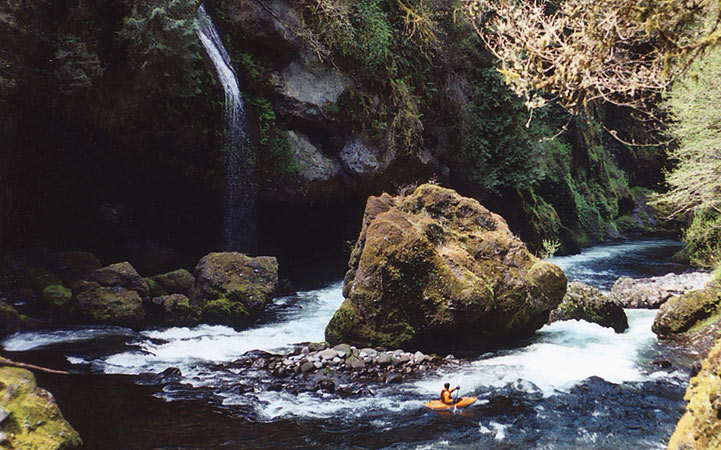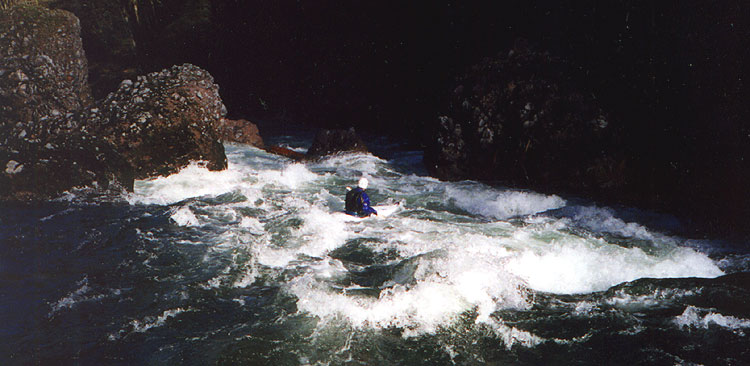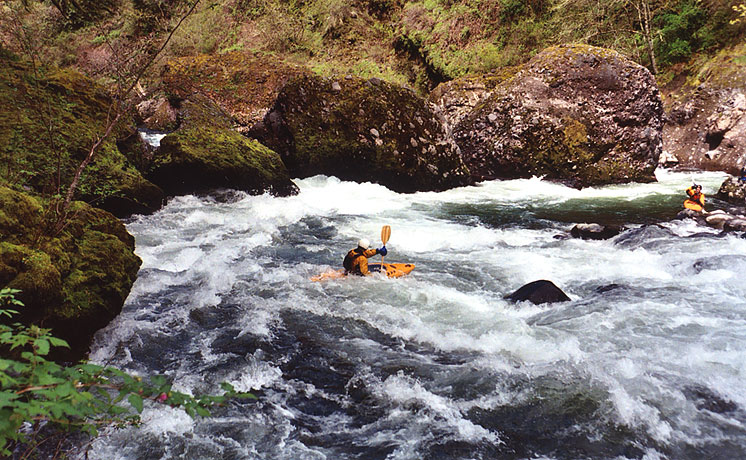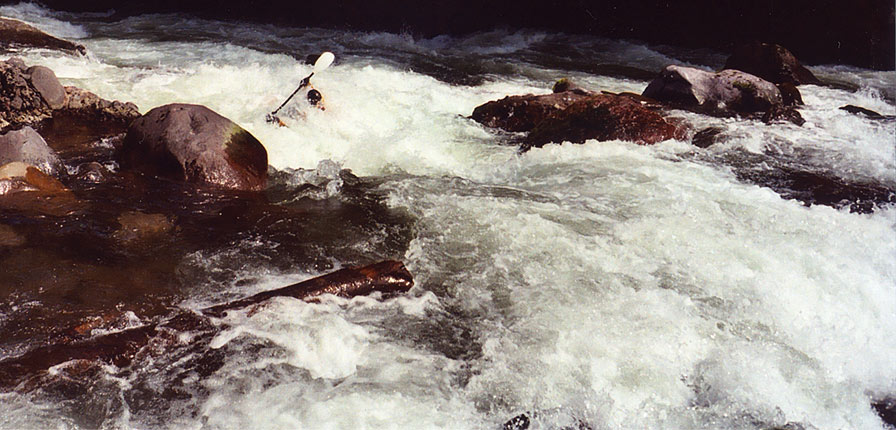The Sandy Gorge

Copyright © 2000-03, Oregon Kayaking.
No part of this page may be reproduced, linked, or copied without the
express written
permission of the Oregon Kayaking Webmaster.
The Sandy River Gorge is an Oregon classic; the river twists its way
through a dark, mossy, Tolkein-esque gorge with some fairly challenging
and sometimes intimidating drops. This section is a great place for
aspiring class four boaters to get a feel for harder whitewater without a
lot of commitment; all of the large drops in the gorge are easy
to scout and/or portage.
Jon Fowlkes at the put-in for the Sandy Gorge

Once on the river paddlers soak up some of the best gorge scenery in the
state while cruising down the many class II-III warm up drops. The rapids
slowly build until
you get to 'Boulder', the first of four class IV rapid in the gorge.
Boulder deserves a scout because it often collects wood. In some years it
is run on the right, and some the left, but that depends on the current
wood arrangement. The left side is always a little sketchy because much
of the water goes under the huge midstream boulder marking the drop. That
said, the only portage line is over the boulders on the left side, visible
in the photo below.
Jon Fowlkes cruises down Boulder Drop.

The next few drops (Rasp Rock and Drain Hole) come in quick succession.
Rasp should always be scouted because the river funnels through a narrow,
bouldery drop that sometimes collects wood..
Pete running Rasp Rock. The log on the midstream boulder is gone now, but
more wood may appear at any time!

On my first trip down I was following Pete, and when we got to Drain Hole
and Pete said "Ok- this one is easy but it looks bad.
Just go where I go.." "Um, Ok.." I said. At Drain Hole the river rushes
down and crashes into a couple of massive boulders that have narrow, wood
filled cracks separating them. Some of the water is forced through these
narrow cracks, creating a giant sieve that is "Not where you want to be.."
to quote Pete as he instructed me how to run it as we sat in the eddy
above. After it hits the boulders the water does a ninety degree turn to
the right, and then another sharp turn to the left. Pete went first and
started far left, directly above the sieve. "Geez, that looks reeeeally
sketchy.." I thought as he appeared to plunge directly towards the
sieve... then suddenly he shot to the right and was in the eddy below. I
went next.... After I was through I figured the best way to run this one
is to not look where the water is going as you round the corner and ride
up on the pillow- it detracts somewhat from what is really a fun rapid!
Steve Stuckmeyer makes 'The Move' at Drain Hole while
Jon watches from the eddy.
The boulder sieve
that forms the 'drain hole' shown below is extremely dangerous and should
be approached
with caution!
This drop is very easy to scout
and/or
portage on the right.

Downstream is some easier water above Revenue Bridge Rapid, which is easy
to scout or portage on the left side. This drop is
visible from the take-out bridge, but first-timers should take note: this
drop is
bigger than it looks! We run Revenue Bridge rapid down the meat, staying left and
going with the flow through some sizable holes...
Jon Fowlkes blasts through the main hole halfway down Revenue Bridge
rapid.

FLOWS:
Pete Giordano has run this section as much as anyone, so here's the scoop
on flows, from Pete:
A good minimum is about 2000 cfs on the Sandy internet Gauge at
Bull Run.
There is also a new gauge below the dam which reflects the
gorge
better. This gauge basically subtracts the diversion from the dam (300-600
cfs) minus the flow in the Bull Run. I don't have a good feel for this one
but I'd say a good minimum is probably 800 or so. Max is yet to be
determined but I ran it last year at 6500-7000 cfs and it was completely
good
fun, the boulders at Rasp Rock covered, etc..
Lots of people use the foot gauge and that probably ranges from 9.5
ft. to 13.5 ft. respectively. I've run it at minimum summer flows of 475
cfs and everything was runnable.





